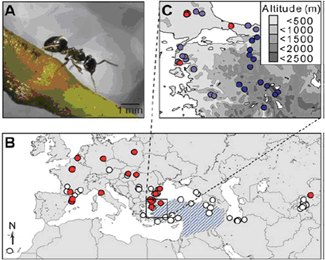Invasive garden ants tells us that more will come

Ants are excellent invaders. Of the 100 worst invasive species in the world, five are in ants. The recent work in another species, the invasive garden ant (Lasius neglectus), in full expansion in Europe, tell us why some species can be as good invasive. And warn that the more than 12,500 species of ants that are known, much more we can give you headaches if you do not take appropriate measures. One of the keys is that the ants are those invasive species that make nests networks, with many queens who s'aparellen below ground and not make swarms. A team of 20 researchers, focusing on the universities of Copenhagen (Denmark) and Regensburg (Germany) have studied this species, the name of the be indicating that it had been widely neglected: a description that is not its existence-date 1990.
Since then it has spread to more than 100 locations in many European countries. It is in parks and gardens, remove quickly on the native species and often enters houses, where there is a real problem. Now the appearance of the black garden ant but is a bit small, brown-with-milk, and its activity up and down the trees is up to nine times higher. Can proliferate in temperate zones of Europe and Asia, being the first ant pests that can invade these areas cold, so far not affected by other more tropical pests. To the north, has come to Jena (Germany), Ghent (Belgium) and Warsaw (Poland).
Fig 2. Typical colonial forms of organization. Nearby nests (white circles) are colonies (large circles in color) at different levels that allow varying degrees of coexistence with other species of ants (black circles).
Colonies of ants are usually made up of small companies, competing with the neighbors, but the invasive ants can be enormous supercolònies of thousands of nests in partnership with •. Was much discussed how and why this change in the social structure. This paper presents the first integrated study of the behavior, morphology, population genetics, recognition and chemical load of parasites among comparatively L. neglectus and sister species, not invasive, L. turcicus. We show that the conditions to develop this syndrome of invasive ants are already in the towns of origin. However, the ability to invade is only when all the ants have escaped their natural enemies such as parasites and pathogens, which takes place when they reach remote villages, where local parasites and enemies have not had time to adapt and respond to new coming.
In addition, it has been detected these biological features likely to invade in the Turkish garden ant (Lasius turcicus), hitherto entirely inconspícua. This means that transport is not wanted, but real and effective, we humans in the international trafficking and trade that characterize today's society inevitably du transport of species into new habitats, and also disrupts the balance of the ecosystem by encouraging the transition of introduced species to pests that can be devastating. Only awareness of this problem, and a more careful control of global trade, can help curb the problem of alien invasive species.
For further information about L. neglectus: http://www.creaf.uab.es/xeg/Lasius/Espanol/indice.htm
References
Cremer, S.,et al. The evolution of invassiveness in garden ants. PLoS ONE 3(12): e3838 doi:10.1371/journal.pone.0003838


